A few months ago, I reviewed the WowWee Cinemin Swivel pico projector. It was the first pico projector that I had tried out and put down a pretty high standard. Since then and after reading through various articles and press releases coming from CES, it seems that my prediction that pico projectors would be hot this year may be coming true. In this article, I’m looking at another pico projector that is a bit more powerful and more “business-class” – the Aaxa P2 pico projector.
For those who do not know what Pico projectors are, they are essentially very compact and portable projectors that one would attached to a computer or video device to project images or video on a screen or wall. Most places of business have larger projectors to show presentations or other media. Some people use projectors with higher resolutions as replacements to big-screen TVs since you can simply turn them off on put them and the screen away. I recently wrote about how my neighbor set up a backyard theater using a projector. The pico projector uses the same concepts of displaying video or other media via projection, but with a much smaller form factor. Some pico projectors are now even starting to appear in phones and recent technology changes are moving from bulbs to lasers.
A few weeks ago, I received another pico projector, the Aaxa Technologies P2. It is interesting to see the differences between the two so I encourage you to read the Cinemin review prior to this one as I will make a few comparisons. While similar in product category, their implementation is quite different.
First, let’s get some of the technical specifications out of the way.
Technical Specifications
The Aaxa P2 has the following impressive specifications:
- Resolution: SVGA (800×600)
- Brightness: 33 ANSI-Lumens
- Contract Ratio: 1000:1
- Aspect Ratio: 4:3
- Lens: Manual focus
- Audio output: 1W stereo speaker with headphone mini-jack
- Dimensions: 100 x 59 x 27 mm
- Weight: 260g
- Power Consumption: 15w
- Battery: DC 1700 mAh battery
- Video formats supported: MP4, AVI, WMV, SMV
- Audio formats supported: MP3, OOG, WAV
- Other formats supported: BMP, JPG, GIF, TXT
- Storage: 1GB internal flash memory + microSD reader
- Noise: 30dB
The device itself has a VGA input (D-Sub) and a Composite A/V input (3.5mm jack). There is also a 3.5 mm Stereo headphone jack and a 5-pin mini USB port. The full packaging includes the projector, and external battery, an attachment to help charge the battery when it is not attached to the projector, an infrared remote and a tripod as well as a VGA cable and Composite A/V cable adapter.
To put this device in perspective with the WowWee Cinemin, the Aaxa P2 has a better ANSI lumen brightness (33 for the P2 vs. the 8 for the Cinemin), has a better resolution (P2: SVGA – 800×600 vs. Cinemin: HVGA – 480×320. According to the Aaxa website, with the VGA connector, you can get direct VGA connection resolutions up to 1280×720.
Another difference between the Cinemin and the Aaxa P2 is the fact that the P2 has 1GB of memory built in to the device as well as a MicroSD slot that can handle cards up to 4GB in size. The Cinemin has no built-in memory nor a MicroSD card reader.
The size is about the same, provided you don’t have the battery attached to the Aaxa P2 and simply have it plugged into a wall power supply.
Using The Aaxa P2
The Aaxa P2 is quite a different projector compared to the Cinemin. For starters, and one thing that did actually annoy me, was the fact that the fan is loud and always running. When you use a device like this, you typically have it close to your person, so, unless you are using external speakers or headphones, you will definitely hear some fan noise.
The other design decision that I found interesting is the battery. It is external to the projector completely. While this means that you can pack in more components into the main unit (including the larger fan), it does also mean that it is a bit more bulky and inconvenient. The battery does securely fasten to the main projector unit but it doubles the thickness of the device. In comparison to the Cinemin, the P2 is a lot less portable. However, the P2 is much more suited to setting up a mobile presentation solution within your home or office. You can plug the P2 in without the battery directly to a wall plug. The included mini tripod is GREAT to have as it makes positioning the P2 really easy.
Unfortunately, the documentation is a bit sparse and could use some refinements. But Aaxa supported me throughout my initial testing process (which was a bit involved). I definitely recommend that you read through the documentation so that you know some of the tricks to playing various media. For example, to turn it on, you need to slide the power button on the side of the device, then hit the power button on the top. After that, if you hold the PLAY button, you can start the Mp4 players software that is built in. Otherwise, you can connect either a VGA monitor (with the supplied cable), a video device like a DVD player (with the supplied cable) or an iPod or iPhone (with an optional cable).
Below is a video that shows the P2 features as well as it in action. Obviously, it cannot show each and every thing but should provide you with a pretty good overview of the Aaxa’s functions.
For me, the Aaxa P2 is a bit unpolished and could use some tightening up. For example, as I was testing it, I somehow managed to corrupt the internal storage area which actually managed to erase the firmware and software used to play music, video and show pictures. I believe that the corruption happened as I was connecting it to a Mac and trying to get various files to load. I’m still unclear as to how it happened. However, the nice folks over at Aaxa gave me instructions on how to reflash the firmware to get it back to factory setting. (Note, I would think that having a reset button on the device would at least have some level of firmware built in to be able to roll back automatically to that level during a hard reset. While it might have that functionality, I struggled to find it.) I tried to reset the firmware using the instructions that were provided, first on a Mac and then on a Windows 7 machine and despite trying and trying, there was one step that I just couldn’t get to work (that of mounting the various hidden drives on the P2 in order to overwrite the firmware on those drives). So, the support people at Aaxa asked me to ship it back to them so that they could re-flash it. I found out that for starters, the flashing doesn’t work on Macs (something to do with how the filesystems work) and might not have been tested on Windows 7. They reflashed my drive using Windows XP and sent it back to me in fully working order.
After restoring the firmware, my testing got back on track.
Connecting a video source is fairly straight forward. Using the supplied VGA cable (and my own VGA to DVI connector), I was able to display the screen of my MacBook Pro with a resolution of 800×600. Similarly, I could easily connect the P2 to a netbook or laptop. There is a composite A/V input which you can use to hook up a portable DVD player or other video device. For example, you use this input to connect iPods or iPhones to show movies or videos using an optional iPod connector (Aaxa sells one but you can also use other Apple A/V doc connectors). There is a composite A/V cable supplied that lets you connect to a Red/White/Yellow audio/video cable like a Wii or an Apple A/V doc connector cable.
Note that if you connect an iPod, there are only a few places where you can view output from it (and this is how Apple designed things). For example, any video within your iPod application should be seen just fine as will slideshows that come from the photo application (assuming you are in slide-show mode). However, if you are on an iPhone and using a different application, you will NOT be able to output the video or image. This is simply an Apple limitation and not the fault of the Aaxa P2 (or other Pico projectors).
The Bad
Every product has a good and bad side to it, and I feel it is important to highlight some things that I do and don’t like about each one I review. A few things that stood out on the “bad” side for the Aaxa P2 are:
- Loud & persistent fan noise – I mentioned this already but I really wish there was a way to not only keep the device cool but also do it in a quiet manner. Perhaps laser-powered pico projectors will overcome this? Also, since the lamp of the P2 is brighter (compared to the Cinemin), I’m assuming that it runs a bit hotter as well.
- External Battery – If you have the battery attached, the entire portable is twice as big. I’m sure there is an advantage to having the battery external to the device. It would keep the device cooler, potentially allow for a larger, longer lasting battery as well. Unfortunately the battery life is only said to last about 35 minutes so it’s recommended that you keep the Aaxa P2 connected to a power supply.
- Non-intuitive Interface – It wasn’t until I read the instructions that I knew there was a complete menu infrastructure for various media playback from internal memory or a micro-SD card. Having to push, and hold, the play button to launch that interface is not something that I would have thought of on my own.
- Finicky File Formats – you have to ensure that whatever video you put on the device not only fits into the supported formats, but also the supported resolutions. This is pretty common to all devices.
The Good
On the flip side, there are several positives to the Aaxa P2. For example:
- Brighter output – 33 lumens is pretty bright actually, especially when you compare with the Cinemin. With that type of output brightness, you only need a dim room, not complete darkness.
- On-board storage – with almost 1 GB built in, you can store movies (e.g., for kids) or videos that persist with your device. This can be also great for business people who show movies regularly. I’m thinking that there might be a cool thing I can do at Halloween with it as well.
- Large output footprint – with the ability to through up to a 60″ picture in a dim room, that is truly amazing when you think about the small device it is coming from. If you have complete darkness, you can project an image as large as 80″ (I have not tried this).
- Good extras – in the package are a variety of “extras” like a tripod and holder to easily charge the external battery.
- Internal Management – not only can you simply connect to an external video source like a computer, iPod, DVD player or game console, there is also a built in software suite to manage and play other media types that is stored in the on-board storage.
Summing It Up
Bad and good things aside, I still strongly believe that Pico projectors will continue to be hot and the technology will get better as components get smaller and more energy efficient. The Aaxa P2 is, in my opinion, a great device for the traveling business person who needs to be able to project slideshows or other presentations on-the-fly. Additionally, the P2, when coupled with a set of powered speakers and a portable DVD player, could make a very nice “portable” entertainment system. The P2 is small to easily store away when not in use, quick to set up, fairly easy to use and produces a quality picture. While the fan noise is noticeable, you get used to it and could be easily overcome with the use of external speakers or headphone. Or, if you are on a plane, simply use headphones to project a movie onto the back of the plane seat (you can probably get a quite good picture due to the close proximity between projector and seat back).
At a retail price of $399 (currently on sale for $339), it’s fairly reasonable for what you get. The Aaxa has a powerful LED output that is much stronger than many competitors. The built-in storage allows you to store movies or pictures which makes it a great device for on the go, without any other dependencies. It is also available on Amazon for about $340.
Disclosure Text : I have a material connection because I received a gift or sample of a product for consideration in preparing to write this content. I was/am not expected to return this item or gift after my review period. More information can be found in my About page as well as here.
HTD says: When choosing a Pico projector, be sure to look closely at all of the tech specs and if you can, get a demo.
[amazonproduct=B002TN90UW]
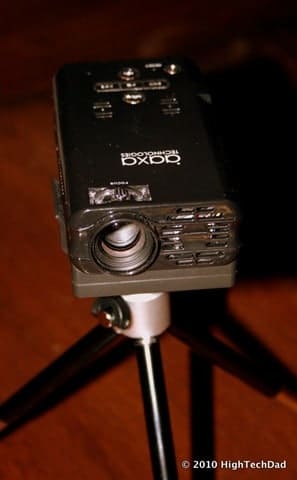
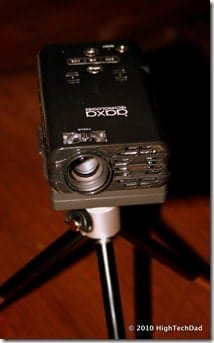
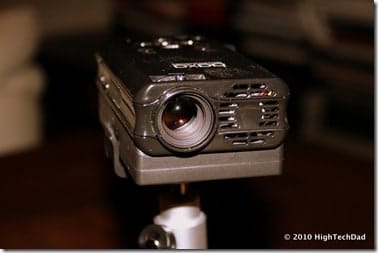
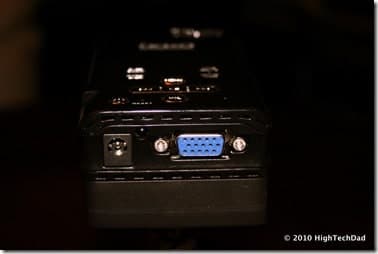
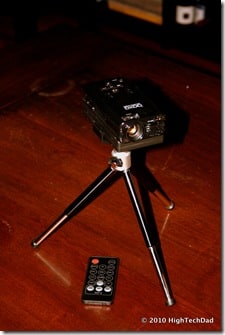
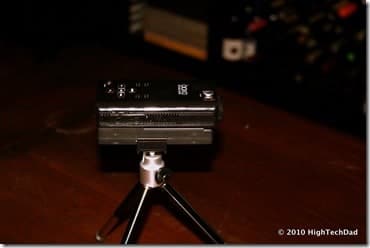


12 comments
Jaime Israel López
Buenas tardes,
Tengo el Proyector modelo “P2 Pico Projector”, en excelente estado y practiamente nuevo, hace poco dejo de mostrar el menú, mismo que aparecía al presionar la tecla de “Play/Pause” es decir en este modelo el menú se abre con esa tecla y NO con la que dice “Menú”, no sé por que ustedes asi lo hicieron y asi viene en el instructivo, sin embargo como les digo, dejo de funcionar y no tengo otra forma de abrir menú y las configuraciones, el control remoto lo perdí hace tiempo así que no puedo probar con el control remoto
Se me ocurre que quizá se daño algún archivo de su memoria interne, ya he buscado por varios meses en su sitio de internet archivos de soporte o algo asi pero no encuentro nada
El Producto me gusta Muchisimo y me es muy útil en mi trabajo, lo he cuidado muy bien y les reitero que el proyector esta prácticamente nuevo
Ojalá puedan ayudarme
GRACIAS
Guest
Hello,
Would you be able to recommend other micro/small projectors that have comparable specs to the AaxaP2, yet more compatible with Macs? And maybe silent (without fan noise) too??
Also, I wanted to project onto curved or uneven surfaces — do I need a laser projector to do that or will an LED bulb projector work?
Please let me know, thanks!! – Thomas
hightechdad
I would be sure that you search for the one with the most lumens. That will be the most important thing. There are some newer projectors out there that use lasers I believe so I would look at those as well. This projector works pretty well but might be due for a refresh. I had some firmware and usability issues with it.
The Swede
Hi,
Tried one of the less brighter pico projectors and felt really let down by the lack of brightness. IN a pitch dark room persons faces in the video could not be seen. Unfortunately I live in Sweden and the pico projectors are hard to find if you need one with a few more ANSI-lumen. Looking through your review it seems like Aaxatechs P2 Pico Projector has solved that problem. My dilemma today is if I will regret a potential order or if the projector will be as good as I think it is. It seems like on all the video reviews on and off youtube it is not easy to see the actual brightness of the projector. Am I able to see the faces of the persons in a movie or is it as bad as the projectors with a lower ANSI-lumen? My usage will be for projecting movies and potentially using it in my work to make presentations…Thank you for a very good review!
Best regards
The Swede
hightechdad
I really recommend that you contact their support.
Seth
I spent an entire day trying various video formats and codecs that are supposedly supported. None would work. The built in media player is useless for video.
hightechdad
Hi Ian,
I cannot remember off the top of my head honestly. I would suggest sending Aaxa a support request via their form here: http://www.aaxatech.com/support/contact.php . They are pretty good at getting back (at least they were with me). I can dig around for the manual but you can download it here as well: http://www.aaxatech.com/pdf/P2_Manual.pdf
Good luck!
Ian
Hi Michael,
In one of your paragraphs on P2 projector, you mentioned that not only we have to use the correct format, but also to choose the correct resolution. What is the resolution, if I want to project video from my Iphone/Ipod touch or from the MicroSD?
THanks
Ian
Danilo Mauro
I wrote them at the e-mail address that I found on the support page on their website but I had no reply from them.
Thank you in any case. All the best!
Guest
Hi! I’ve had the exact same problem, with a Mac. It just happened yesterday, and it seems it was after I first used the VGA output connection for non-MP4 player use. Now I have no MP4 option. Unfortunately, I have a public presentation tomorrow night that requires the Mp4 player, so if anyone knows a faster way than sending this thing in for servicing, with either Mac or PC, please let me know!!
hightechdad
Yeah, that is exactly what I ran into. It isn't too Mac friendly unfortunately. I would contact their support and see if they can help you . They did help me out but it involved sending the unit back to be reflashed. Perhaps they have a different way to make it work better. You can tell them that you had the same issue that I encountered. Who knows, it might help.
Do let me know what they say. Good luck!
Danilo Mauro
Last week I bought an AAXA P2 pico-projector, and I also had some problems in connecting it with my MiniMac. I deleted only one .avi file using my computer and now I cannot use the MP4 player because there is no folder anymore. I think that my problem is similar to yours.
Which are the instructions to reflash the firmware? I have not succeeded in finding them.
Thank you very much for your help.
Best regards, Danilo